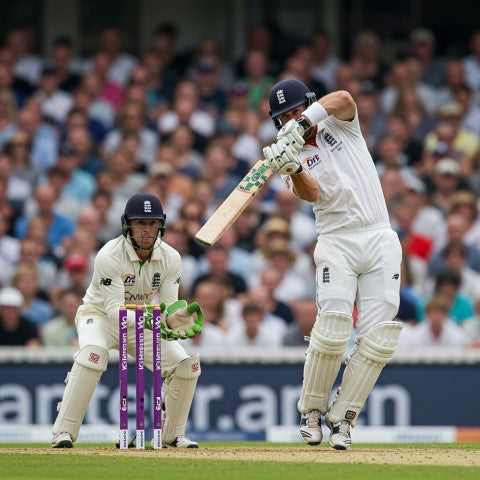Why Fast Bowlers Ice Their Legs After Every Spell

They steam in from 30 yards, slam their front foot into the turf, hurl a 90mph rocket, and then do it all again — over after over. Few roles in professional sport are as physically brutal as that of a fast bowler. So when the over ends and they reach for the ice packs, it’s not just a post-match ritual — it’s a carefully calibrated response to one of the most demanding workloads in cricket.
The sight of bowlers strapping frozen sleeves around their thighs or calves has become commonplace in the modern game. But why do fast bowlers ice their legs after every spell? Is it genuinely beneficial, or simply a placebo effect backed by sports science jargon?
The answer lies somewhere between biology, physics, and long-term career preservation. From muscle microtrauma to inflammation control and recovery timing, icing is an integral part of how the modern fast bowler operates — especially when matches span five days or a three-match T20 series squeezes into a single week.
This article breaks down the science, strategy, and subtle genius behind that unassuming bag of frozen relief. Because in a world of high performance, even a 10-minute ice session can be the difference between a comeback spell — or a breakdown.
1. The Physical Toll of Fast Bowling
Fast bowling is often romanticised for its speed and aggression, but underneath the spectacle lies a relentless toll on the human body — especially the legs.
Every delivery exerts enormous force through the bowler’s body, particularly at front-foot impact. That single motion — landing, bracing, and delivering — can generate ground reaction forces more than five times the bowler’s body weight. This places serious stress on the:
-
Knees: absorbing the brunt of landing and stability
-
Hamstrings and quadriceps: responsible for deceleration and explosiveness
-
Calves and ankles: maintaining balance and pushing through the crease
Across a Test match, a bowler might deliver 120+ balls in a day. That means hundreds of high-impact actions repeated with minimal recovery — a recipe for muscle fatigue, joint stress, and micro-tears in soft tissue.
Add travel, poor sleeping conditions, or back-to-back matches, and the risk of injury escalates. The legs, which are critical for pace, rhythm, and control, become the first to fatigue and the hardest to restore.
So, when fast bowlers ice their legs after every spell, they’re not pampering themselves — they’re fighting against a clock that’s already ticking toward breakdown.
2. The Role of Inflammation in Recovery
When a bowler finishes a taxing spell, their muscles are hot, tight, and inflamed. That’s not a bug — it’s the body’s natural response to physical stress. Inflammation rushes blood, nutrients, and immune cells to the area to begin the repair process.
But there’s a trade-off: too much inflammation leads to swelling, stiffness, and pain. In the short term, it slows down muscle function. Left unchecked, it can increase the risk of strains or tears in the next spell or match.
This is where icing the legs comes in.
By reducing surface temperature of the muscles and surrounding tissue, ice:
-
Slows down blood flow and inflammation
-
Minimises the accumulation of fluid and waste around the joints
-
Reduces pain signals sent to the brain
-
Helps restore range of motion more quickly
It’s not about stopping inflammation entirely — that would hinder recovery. It’s about managing it so bowlers can stay functional, mobile, and ready for their next stint with the ball.
Think of it as controlled damage control: a fast way to soothe overloaded legs without interfering with longer-term muscle rebuilding.
3. What Icing Actually Does to the Muscles
The science behind icing isn’t just old-school sports lore — it’s backed by physiology.
When you apply ice, it causes the blood vessels in the area to constrict (vasoconstriction). This reduces the flow of blood and inflammatory substances into the area, lowering tissue temperature and slowing metabolic activity.
In practical terms, that means:
-
Less pain from nerve endings
-
Less swelling around the joints
-
A numbing effect that promotes movement without discomfort
-
Reduced muscle spasms and cramping
For fast bowlers, this helps “reset” the legs — especially the quads, hamstrings, and calves — between spells. Even short icing sessions (10–15 minutes) can have measurable effects on soreness and tightness levels in the next few hours.
It also contributes to neuromuscular recovery, allowing bowlers to stay explosive and biomechanically efficient when they return for a second or third spell later in the day.
In elite sport, where recovery margins are razor-thin, icing isn’t just a feel-good habit. It’s a tactical tool — one that’s now as standard in cricket as shin pads and white kits.
4. Timing Is Everything: Why It’s Done Immediately
The key to effective icing? It’s not just what you do — it’s when you do it.
There’s a small window of time post-exertion known as the acute recovery phase — roughly the first 30 minutes after a bout of high-intensity activity. This is when the body is at peak inflammation and muscle temperature is highest.
Fast bowlers ice their legs after every spell to hit this recovery window while it’s still open. Immediate application:
-
Prevents inflammation from spiralling
-
Eases post-spell soreness before it sets in
-
Reduces the risk of delayed onset muscle soreness (DOMS)
-
Accelerates the return to a “neutral” muscle state before the next spell
Waiting even an hour can reduce icing’s effectiveness — which is why you’ll often see bowlers still breathing heavily with ice packs strapped on, mid-innings, surrounded by support staff.
In professional settings, this is managed to the minute. Some teams even have recovery coaches ensuring ice is applied, removed, and rotated based on individual workloads.
It’s not superstition. It’s a race against the body’s own chemistry — one that fast bowlers lose if they don’t act quickly.
5. Preventing Injury, Not Just Treating Pain
At the elite level, prevention is everything. Once a fast bowler goes down with a hamstring tear, knee inflammation, or calf strain, they could miss months of cricket — and with the modern calendar, that often means several formats, leagues, and paycheques.
This is why fast bowlers ice their legs after every spell: not just to feel better, but to stay on the field.
Icing helps prevent:
-
Soft tissue injuries, like quad or hamstring pulls
-
Joint inflammation, particularly in knees and ankles
-
Tendon strain, common in repetitive loading patterns
-
Delayed muscle fatigue, which increases injury risk in later overs
It also fits into broader load management strategies used by national and franchise teams. These strategies involve:
-
Tracking bowler workloads (via GPS, ball counts, and biomechanical analysis)
-
Scheduling recovery windows
-
Incorporating icing, sleep, hydration, and nutrition protocols into daily routines
The goal isn’t to eliminate soreness altogether — it’s to manage it smartly. By reducing acute stress on the legs between spells, bowlers lower the cumulative impact that leads to injury over time.
It’s why some of the world’s quickest bowlers, despite brutal schedules, remain remarkably consistent. Icing isn’t just relief — it’s resilience in action.
6. Ice vs Compression vs Contrast Baths
While icing dominates the post-spell ritual, it’s often part of a larger recovery toolkit.
Compression
Used alongside ice or even during play, compression garments (socks, sleeves, leggings) help reduce blood pooling in the legs and improve circulation. They’re particularly useful for long-haul travel or players with a history of swelling.
Contrast Baths
The old “hot-cold-hot” method involves alternating between warm and cold water. The temperature shifts stimulate blood flow and lymphatic drainage, helping flush out waste products like lactic acid. While less portable than ice packs, contrast therapy is often used after matches or training.
Recovery Boots
Devices like NormaTec recovery boots offer pneumatic compression and mimic massage. These are favoured during tournaments where turnaround time is short.
So why do fast bowlers still rely most heavily on icing their legs after every spell?
-
It’s fast
-
It’s targeted
-
And it’s easy to implement between spells, even mid-innings
In a perfect world, bowlers might rotate through contrast baths and compression therapy too. But when the overs keep coming, ice gets the job done.
7. Case Studies: How the Pros Manage Recovery
Top-level fast bowlers don’t just bowl fast — they recover fast. And if there’s one thing they all do, it’s ice their legs after every spell.
Jimmy Anderson
England’s legendary swing bowler, still going strong in his 40s, is religious about recovery. Ice, stretching, and massage are part of his daily rhythm. He’s repeatedly said that longevity is less about talent, more about maintenance.
Pat Cummins
Once plagued by injury, Cummins now exemplifies modern sports science in action. The Australian captain adheres to a strict icing regime, especially during the rigours of multi-format tours.
Jasprit Bumrah
Known for his explosive, unorthodox action, Bumrah’s legs take an immense load. His recovery routine is meticulously managed — from ice baths post-IPL matches to manual therapy sessions and gym-based prehab.
These athletes are backed by physios, strength coaches, and recovery staff — but the consistent thread? They always ice their legs. Because the science may evolve, but the need to reduce load and inflammation remains a constant.
8. Beyond the Ice Pack: Full Recovery Protocols
While icing is a key piece of the puzzle, it’s just the start of a full recovery protocol that modern fast bowlers follow like clockwork.
Other components include:
-
Hydration: Replacing fluids and electrolytes to prevent cramping and fatigue
-
Nutrition: Consuming protein and anti-inflammatory foods to rebuild tissue
-
Sleep: The ultimate recovery weapon — hormonal repair, memory processing, and immune regulation all kick in overnight
-
Stretching and mobility work: Preventing tightness in hips, hamstrings, and lower back
-
Active recovery: Gentle jogging, swimming or cycling to keep blood flow steady without further impact
Recovery isn’t an indulgence — it’s part of the job description. Especially in tournament cricket, where bowlers may be back on the field within 24 hours, every edge counts.
So while fans may only see the ice on the legs, the reality is that every top-tier fast bowler walks a tightrope of recovery science. And the ice pack? That’s just the most visible tip of the iceberg.
Conclusion: Why Icing Legs After Every Spell Isn’t Just for Show
To the casual observer, watching a fast bowler strapping frozen packs to their thighs might seem like an odd quirk — or worse, a performative gesture. But in cricket’s ever-evolving world of science, load management, and high-stakes schedules, icing the legs after every spell has become non-negotiable.
It’s not about luxury. It’s about performance. It’s about preservation. It’s about keeping that rhythmic, high-speed engine from overheating — and from breaking down entirely.
Icing allows bowlers to:
-
Reset between spells
-
Manage inflammation before it turns to injury
-
Protect their legs, their careers, and their countries' hopes
So the next time you see a bowler iced up on the boundary, know this: they’re not just cooling off. They’re gearing up for another spell of thunderbolts — and giving themselves the best shot to do it all again tomorrow.





Leave a comment